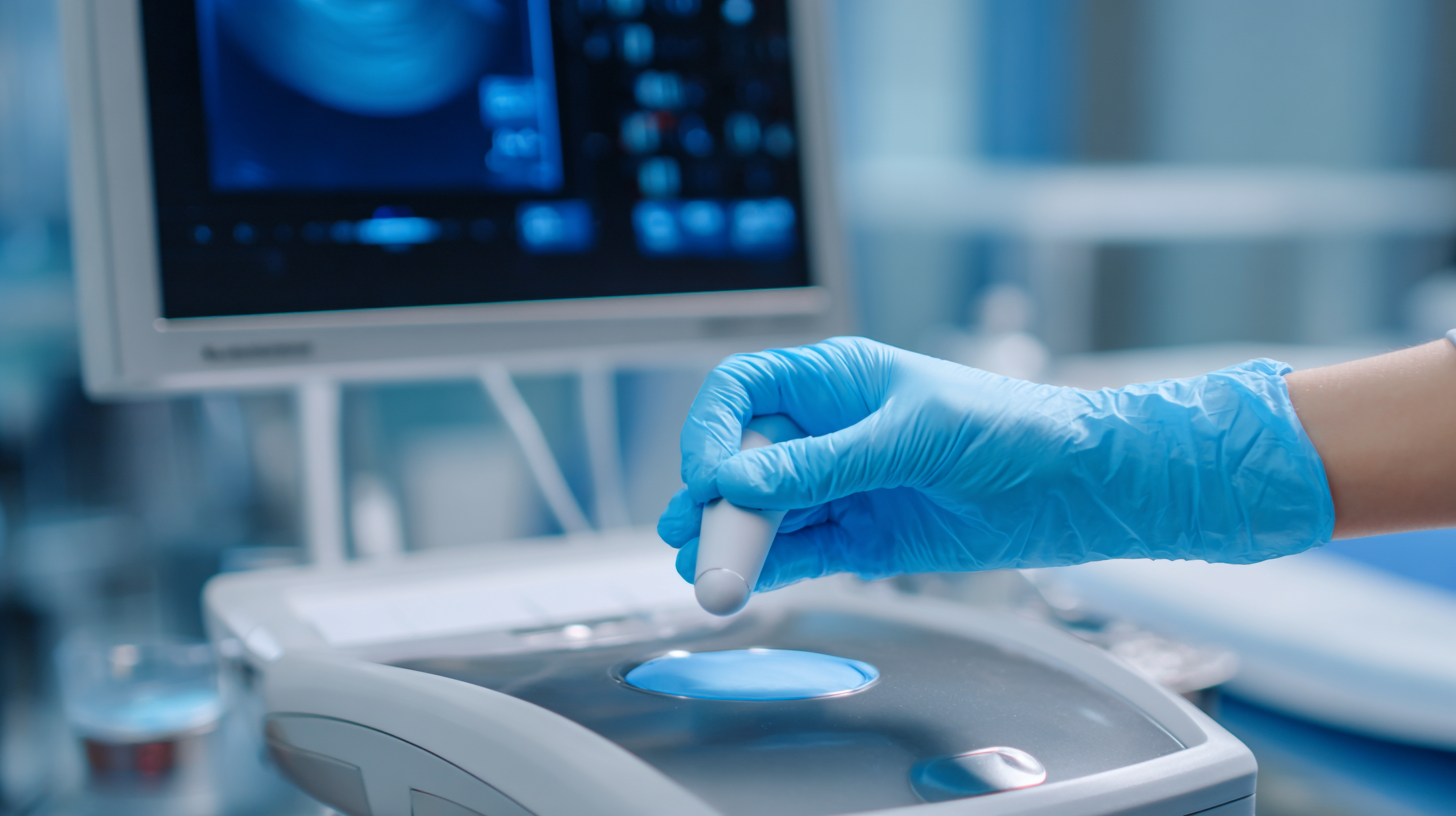5 Compelling Reasons to Choose Ultrasound Gel for Your Medical Imaging Needs
In the ever-evolving field of medical imaging, the choice of materials significantly impacts diagnostic accuracy and patient comfort. Ultrasound gel plays a critical role in optimizing imaging quality by providing a seamless acoustic interface between the transducer and the patient's skin. According to a report by MarketsandMarkets, the global ultrasound market is projected to reach $9.4 billion by 2025, underscoring the growing reliance on this technology for various medical diagnostics. The importance of ultrasound gel is further highlighted by its ability to reduce image artifacts and improve sound wave transmission, crucial factors in obtaining high-resolution images. As healthcare professionals continuously seek ways to enhance imaging outcomes, understanding the benefits of ultrasound gel can lead to improved patient care and more effective diagnostic processes.

Benefits of Using Ultrasound Gel: Enhancing Image Clarity in Medical Diagnostics
 Ultrasound gel plays a crucial role in enhancing the clarity and accuracy of images in medical diagnostics. One of the primary benefits of using ultrasound gel is its ability to eliminate air between the transducer and the skin. This gel acts as a conductive medium, allowing sound waves to travel more efficiently into the body and return with clearer echoes. The result is enhanced image resolution, which is vital for effective diagnosis and treatment planning.
Ultrasound gel plays a crucial role in enhancing the clarity and accuracy of images in medical diagnostics. One of the primary benefits of using ultrasound gel is its ability to eliminate air between the transducer and the skin. This gel acts as a conductive medium, allowing sound waves to travel more efficiently into the body and return with clearer echoes. The result is enhanced image resolution, which is vital for effective diagnosis and treatment planning.
Furthermore, ultrasound gel provides a smooth application that is comfortable for patients during examinations. Its viscous consistency not only maintains contact but also allows for easy manipulation of the transducer, enabling technicians to capture various angles and views without compromising the quality of the images. This increased accessibility to high-quality data is essential for healthcare providers who rely on precise imaging to make informed clinical decisions. In an era where accuracy in diagnostics is paramount, ultrasound gel remains an indispensable component of medical imaging.
Understanding the Role of Ultrasound Gel in Patient Comfort and Safety
Ultrasound gel plays a crucial role in enhancing patient comfort and safety during medical imaging procedures. This clear, viscous substance forms a vital interface between the transducer and the skin, enabling the effective transmission of sound waves. By ensuring optimal acoustic coupling, ultrasound gel helps to produce clearer images, ultimately allowing for more accurate diagnoses while keeping patients at ease.
**Tip:** To further improve patient comfort, consider warming the ultrasound gel before application. Cold gel can cause discomfort, especially in sensitive areas, so gently heating it to body temperature can significantly enhance the overall experience.
In addition to comfort, ultrasound gel also contributes to patient safety. Its composition is formulated to be hypoallergenic and non-toxic, reducing the risk of adverse skin reactions. Moreover, using high-quality gel minimizes the chances of air pockets forming, which can lead to image artifacts that compromise the quality of the examination.
**Tip:** Always check the expiration date on your ultrasound gel products. Expired gel may not perform effectively, compromising patient safety and diagnostic accuracy.
5 Compelling Reasons to Choose Ultrasound Gel for Your Medical Imaging Needs
This chart illustrates the importance of various factors that make ultrasound gel a preferred choice for medical imaging, highlighting patient comfort and safety as primary considerations.
The Chemical Composition of Ultrasound Gel: What Makes It Effective?
 Ultrasound gel plays a crucial role in medical imaging by facilitating the transmission of sound waves between the transducer and the skin. Its chemical composition is specifically designed to optimize ultrasound performance. Typically, ultrasound gels are composed primarily of water and a thickening agent, along with various antimicrobial ingredients to prevent bacterial growth. According to a report by the American Institute of Ultrasound in Medicine (AIUM), having the right gel formulation can significantly enhance image quality, ensuring accurate diagnostics.
Ultrasound gel plays a crucial role in medical imaging by facilitating the transmission of sound waves between the transducer and the skin. Its chemical composition is specifically designed to optimize ultrasound performance. Typically, ultrasound gels are composed primarily of water and a thickening agent, along with various antimicrobial ingredients to prevent bacterial growth. According to a report by the American Institute of Ultrasound in Medicine (AIUM), having the right gel formulation can significantly enhance image quality, ensuring accurate diagnostics.
The use of non-greasy, hypoallergenic gels is essential, especially in sensitive patient populations. A study published in the Journal of Clinical Ultrasound highlights that gels containing high molecular weight polymers create a better acoustic contact, which is fundamental for high-resolution imaging. Additionally, the inclusion of propylene glycol enhances the gel's viscosity and stability, which allows for uniform application and prevents air entrapment—factors that are critical for maintaining clear imaging under diverse clinical conditions. The effectiveness of ultrasound gel fundamentally lies in its tailored chemical composition, ensuring reliable and precise medical imaging outcomes.
Comparative Analysis: Ultrasound Gel vs. Other Imaging Coupling Agents
When it comes to medical imaging, choosing the right coupling agent is crucial for accurate diagnostics. Ultrasound gel stands out from other imaging agents due to its unique properties that enhance sound wave transmission. Unlike oils or other gels, ultrasound gel is water-based and easily washable, ensuring a patient-friendly experience while maintaining high-quality imaging results. This gel also helps minimize air pockets, which are a common issue with alternative agents, thereby providing clear, unobstructed images that are vital for effective evaluations.
Tips for selecting the best ultrasound gel include checking for hypoallergenic formulations to prevent skin irritation, especially for those with sensitive skin. Additionally, consider the gel's acoustic properties; not all gels are created equal, so opting for a gel with optimal sound velocity can significantly improve image clarity. It's also advisable to choose gels that come in convenient packaging, as this can streamline workflow in a busy medical environment. By making informed choices, medical professionals can enhance their imaging capabilities and ultimately improve patient care.
Industry Standards: FDA Regulations and Quality Assurance for Ultrasound Gel Products
When it comes to selecting ultrasound gel for medical imaging, understanding the regulatory landscape is crucial. The FDA plays a vital role in ensuring the safety and efficacy of ultrasound gel products. According to a recent report, the ultrasound gel market is projected to grow significantly, driven by rising demands in various medical imaging procedures. Compliance with industry standards not only ensures patient safety but also optimizes imaging quality, which is paramount for accurate diagnostics.
In addition to FDA regulations, quality assurance protocols dictate the formulation and manufacturing processes of ultrasound gels. High-quality gels are characterized by their ideal viscosity and acoustic characteristics, essential for minimizing artifact interference. Recent studies indicate that gels formulated with nanoparticles can enhance therapeutic capabilities, showcasing the potential of advanced materials in clinical settings. This innovation aligns with current trends in nanoparticle therapeutics, where nanotechnology greatly improves the performance of traditional treatment methods. Embracing these advancements in ultrasound gel formulations could elevate medical imaging practices to new heights, reinforcing the importance of adhering to industry standards for optimal outcomes in patient care.
5 Compelling Reasons to Choose Ultrasound Gel for Your Medical Imaging Needs
| Reason | Description | Industry Standards | Regulatory Compliance |
|---|---|---|---|
| Enhanced Imaging Quality | Ultrasound gel ensures optimal sound wave transmission, leading to clearer imaging results. | ISO 13485 | FDA 510(k) Clearance |
| Non-Toxic Formula | Formulated without harmful chemicals, making it safe for all patients. | USP Class VI Compliant | FDA GMP Compliance |
| Easy Application | Smooth consistency allows for effortless spreading and minimal mess during procedures. | ASTM D2603 | CE Marking |
| Versatile Usage | Compatible with various ultrasound transducers and other medical imaging technologies. | IEC 60601-1 | FDA Class II Medical Device |
| Cost-Effective Solution | Provides high-quality results at a lower cost compared to other imaging mediums. | ISO 9001 Certified | FDA Registration |
HEMC (Hospital Equipment Manufacturing Company) was established in the year 1981 and has since been engaged in the export of Medical equipments, Hospital equipments, Orthopaedic Implants & instruments, Laboratory equipments, Scientific & Educational products worldwide. Your support has made us a "Government of India" recognised export house. Our goods have reached all continents from "The Americas" to "Europe" and beyond…